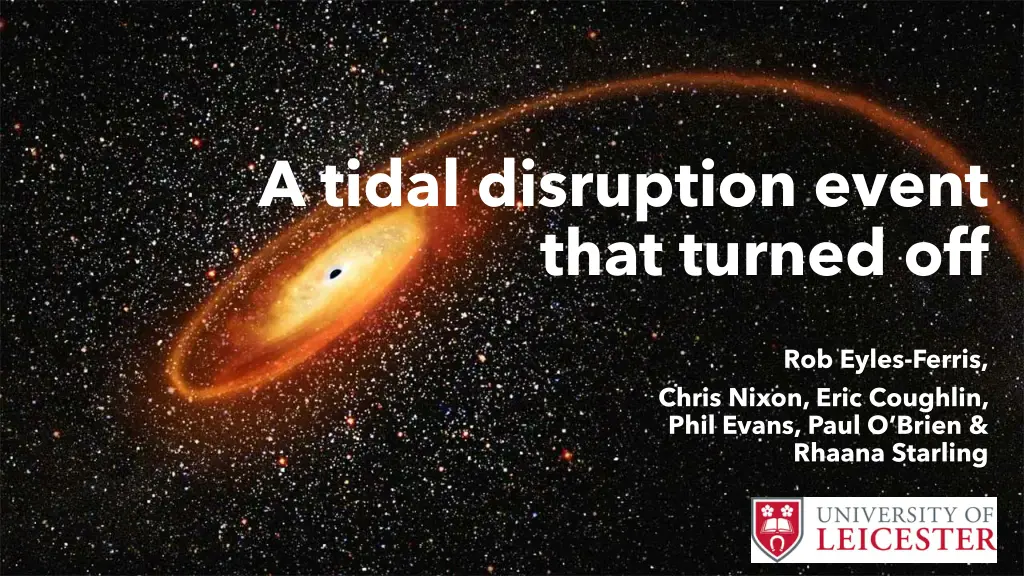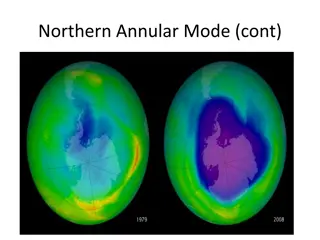
Understanding Tidal Disruption Events
Learn about tidal disruption events where stars are torn apart by supermassive black holes, leading to unique X-ray emissions. Discover how to detect X-ray TDEs and what they look like, including thermal emissions and relativistic jets.
Download Presentation

Please find below an Image/Link to download the presentation.
The content on the website is provided AS IS for your information and personal use only. It may not be sold, licensed, or shared on other websites without obtaining consent from the author. If you encounter any issues during the download, it is possible that the publisher has removed the file from their server.
You are allowed to download the files provided on this website for personal or commercial use, subject to the condition that they are used lawfully. All files are the property of their respective owners.
The content on the website is provided AS IS for your information and personal use only. It may not be sold, licensed, or shared on other websites without obtaining consent from the author.
E N D
Presentation Transcript
A tidal disruption event that turned off Rob Eyles-Ferris, Chris Nixon, Eric Coughlin, Phil Evans, Paul O Brien & Rhaana Starling
What are tidal disruption events? Stars get torn apart when they get too close to a supermassive black hole and ~half the material remains bound to be accreted Fallback rate typically declines as ? 5/3for a full disruption or ? 9/4for a partial disruption Accretion rate can be highly super-Eddington at early times Typical hosts are green valley and centrally concentrated galaxies Bonnerot et al. 2016
How can we find X-ray TDEs? First, we need an X-ray catalogue The Living Swift-XRT Point Source Catalogue All the point sources Swift has observed 342 080 sources as of this morning Living this is a unique resource Has a built in transient detector* Already made a significant TDE contribution with the discovery of rpTDE Swift J0230 Evans et al. 2023 *See poster by Srijan Srivastava
What do TDEs look like (X-rays)? Most emission is thermal from the accretion flow or stream self-interactions Soft or super-soft spectra typical blackbody temperatures ~50 to ~100 eV Decline consistent with fallback rate decline Remain luminous for years (over a decade in some cases) UVOIR counterparts in some cases but not all (probably angular dependence) 4 TDEs (out of ~100) have relativistic jets 3 found by Swift Repeating partial TDEs/QPEs/PNTs Quasi-periodic thermal emission as a star is repeatedly disrupted
How can we find X-ray TDEs? Often look for flaring sources But TDEs are supersoft so can use the spectra instead Works with XMM-Newton (Sacchi et al. 2023) and eROSITA (Eyles-Ferris et al. submitted) Set some criteria and we get ~400 sources to manually classify Picked up pretty much all the TDEs Swift has observed 6 new candidates including LSXPS J0956
How can we find X-ray TDEs? Consistent with a ? 5/3 or ? 9/4 decay (Super)soft thermal spectra Spatially consistent with the nucleus of a galaxy Host often green valley galaxy
So what makes LSXPS J0956 special? Eyles-Ferris et al. in prep.
So what makes LSXPS J0956 special? Eyles-Ferris et al. in prep.
Can we explain this behaviour? Repeating TDEs/periodic nuclear transients do fade quickly Monte Carlo modelling based on observed duty cycles <1% chance of reproducing the light curve But there are other options
Jetted TDEs Some TDEs do show this exact behaviour jetted TDEs Fade slowly before abruptly declining Seems to be tied to black hole mass/accretion rate dropping below Eddington Timescale works with estimated black hole mass But These are jets so should have power law spectra Eftekhari et al. 2024
An off-axis jet How about a structured jet? Viscous-like interactions between jet and medium produces slower moving and dense sheath Line of sight is aligned with the sheath Optically thick Varying optical depth and composite regions produce effective photosphere and quasi-thermal spectrum First example of an X-ray off-axis jetted TDE? Coughlin and Begelman, 2020
Testing the jet model Radio observations can be used to test this model. eMERLIN observed last year Full analysis is on going but non- detection Ejet 1-2 orders of magnitude smaller than Swift J1644+57 Not necessarily ruled out but Eyles-Ferris et al. in prep.
Another option fully bound TDEs Stars are normally assumed to have parabolic orbits Means ~half the material is bound when its disrupted But this fraction depends on the eccentricity of the orbit More circular orbits mean more debris is bound Below ????? Can produce the orbit through Hills capture , all debris is bound Cufari, Coughlin and Nixon, 2022
What do fully bound TDEs look like? Fallback rate rises and initially decays slowly Sudden drop at late time as the entire star is accreted Can derive this time analytically For a Solar type star and a 107 ? black hole, e ~ 0.98 gives required timescale Numerical simulations will confirm First example of a fully bound TDE? Cufari, Coughlin and Nixon, 2022
Conclusions LSXPS J0956 is unique a thermal X-ray TDE that turns off Two possible models Off-axis jetted TDE Fully bound TDE Do all jetted TDEs look like jetted TDEs? Are eccentric orbits common in TDEs and how do they affect them?






















